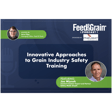Become a Creator today!Start creating today - Share your story with the world!
Start for free
00:00:00
00:00:01

Starting a construction project in the feed and grain industries
Welcome to the latest episode of the Feed & Grain Podcast, hosted by Steven Kilger. In this exciting two-part series, Alex Kerrigan, vice president of Project Development at Todd & Sargent discusses the intricacies of initiating construction projects in the feed manufacturing and grain handling sectors.

















